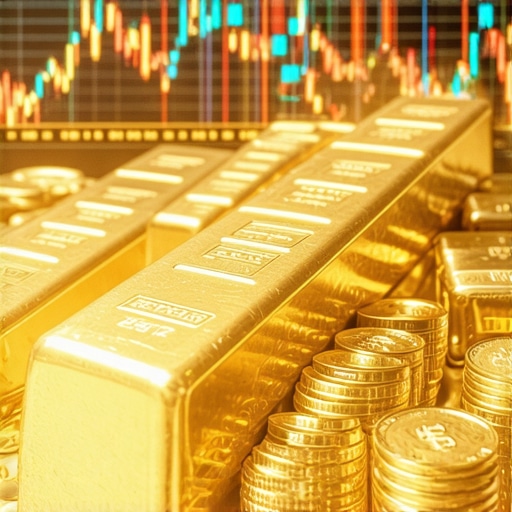Deciphering the 2025 Gold Market Trajectory: An Expert’s Perspective
The gold market stands at a pivotal juncture in 2025, shaped by complex supply-demand interactions, geopolitical tensions, and evolving macroeconomic policies. As seasoned analysts, we explore the nuanced forces influencing gold prices and how investors can capitalize on emerging trends. This comprehensive analysis integrates macroeconomic indicators, central bank activities, and technological innovations to provide a layered understanding of gold’s future in 2025.
Understanding the Supply Chain: How Will Mining and Recycling Impact Gold Availability?
In 2025, the supply of gold is increasingly influenced by both traditional mining operations and the burgeoning sector of recycled gold. Advances in extraction technology, coupled with environmental constraints, are reshaping supply dynamics. According to recent reports from the World Gold Council, the supply from newly mined gold is expected to stabilize, while recycled gold could account for a larger share of the market, affecting liquidity and price stability. These shifts demand that investors monitor gold supply-demand trends carefully to anticipate price movements.
Demand Drivers: Jewelry, Investment, and Technology Sectors
On the demand side, 2025 witnesses a nuanced interplay among various sectors. Central banks continue diversifying reserves with gold, driven by uncertainties in fiat currencies and geopolitical risks. Meanwhile, the jewelry industry’s demand remains resilient, especially in emerging markets, fueled by economic growth and cultural factors. The technology sector’s growing need for gold in electronics and renewable energy further stabilizes demand. For a detailed analysis of these demand factors, see gold demand trends.
Expert Question: How Will Global Economic Trends Shape Gold’s Price Path in 2025?
What are the key macroeconomic indicators that will influence gold prices in 2025, and how should investors interpret them?
Investors should pay close attention to inflation rates, interest rate policies, and currency stability. According to a recent market insights report, rising inflation and dovish monetary policies tend to support gold prices, whereas high interest rates and a strong dollar can exert downward pressure. Analyzing these indicators within the broader geopolitical context enables strategic positioning and risk mitigation.
Strategies for Navigating 2025’s Gold Market
Building a resilient gold portfolio requires diversification across physical gold, ETFs, and mining stocks, aligned with an in-depth understanding of supply-demand dynamics. Effective risk management involves leveraging diversified investment strategies and staying informed of market drivers. Additionally, exploring gold futures can offer tactical advantages, provided traders employ disciplined technical analysis, as elaborated in futures trading techniques.
For those seeking secure physical gold investments, adhering to best practices for safe gold buying remains essential. As the market evolves, staying informed and adaptable will be key to maximizing returns and safeguarding wealth in 2025.
Leveraging Technological Innovations for Smarter Gold Investments
As the 2025 gold market evolves, investors must recognize the transformative role of technological advancements. Innovations like blockchain for provenance verification and AI-driven analytics enable more transparent and informed investment decisions. For instance, blockchain technology ensures the authenticity of gold assets, reducing the risk of counterfeit products—crucial in safeguarding your portfolio. Similarly, AI tools can analyze market sentiment and predict price movements, giving investors a competitive edge. To explore how to integrate these tools into your strategy, visit develop a diversified gold portfolio effectively.
Understanding the Impact of Global Political Shifts on Gold Prices
geopolitics continues to influence gold’s trajectory significantly. Tensions in key regions, trade disputes, and shifts in international alliances can trigger volatility, creating both risks and opportunities. For example, increased sanctions or conflicts often lead central banks and investors to seek refuge in gold, pushing prices upward. Conversely, resolution of conflicts or easing geopolitical tensions can diminish the safe-haven demand. Keeping abreast of global political trends is vital for timely decision-making.
What emerging geopolitical developments should investors monitor to anticipate shifts in gold prices in 2025?
Investors should watch diplomatic relations, military conflicts, and international trade agreements. Additionally, the actions of major central banks, especially their gold reserve management, provide crucial indicators. According to a recent market insights report, strategic shifts in reserve allocations by countries like China and Russia could significantly influence gold supply and demand dynamics in 2025. Staying informed allows you to adapt your portfolio proactively and capitalize on emerging trends.
Expanding Your Investment Horizon: Gold-Related Assets Beyond Physical Bullion
In 2025, diversifying into gold-related assets such as ETFs, mining stocks, and futures can enhance portfolio resilience. Gold ETFs offer liquidity and ease of access, while mining stocks can provide leveraged exposure to gold price movements. Futures, however, require disciplined technical analysis and risk management, especially in volatile markets. For expert guidance on building a comprehensive gold investment strategy, consider building a long-term gold investment plan that aligns with your risk appetite and objectives.
Moreover, understanding supply-demand fundamentals will empower you to identify potential profit opportunities and protect against downside risks. Remember, a balanced approach combining physical gold, financial instruments, and strategic insights is key to thriving in the 2025 gold landscape.
How can investors effectively combine physical gold with digital assets to optimize their 2025 portfolio?
Blending physical gold with digital assets like ETFs or gold-backed cryptocurrencies offers diversification benefits and liquidity advantages. This approach also helps hedge against different economic scenarios. As highlighted in gold IRA investments, a portion of your holdings in physical gold can provide stability, while digital assets enable quick adjustments based on market conditions. Combining these strategies allows for a flexible and resilient portfolio, prepared for the uncertainties of 2025.
If you want to deepen your understanding of these advanced strategies, share your insights or questions in the comments below. For further reading, explore our comprehensive guides on top gold coins for wealth preservation and gold price trend predictions for 2025.
Unraveling the Complexity of Gold Price Drivers in 2025: An Expert Deep Dive
As we navigate through 2025, understanding the multifaceted influences on gold prices is paramount for seasoned investors seeking to optimize their portfolios. Beyond surface-level trends, the intricate dance between supply constraints, technological advancements, and geopolitical tensions creates a dynamic landscape that demands sophisticated analysis. This article explores these factors through an expert lens, offering actionable insights for those aiming to stay ahead in the gold market.
The Evolving Gold Supply Ecosystem: Technology, Recycling, and Regulatory Impacts
In 2025, the traditional mining sector faces unprecedented challenges and opportunities. Innovations such as bio-hydrometallurgy are revolutionizing extraction processes, reducing environmental impact and potentially increasing yield efficiency. Concurrently, the recycling of gold from electronic waste has surged, bolstered by advances in chemical separation techniques, as detailed in a recent World Gold Council report. This shift not only stabilizes overall supply but also introduces a new layer of complexity in market liquidity and price stability. Investors must consider how these technological and regulatory evolutions influence supply forecasts and anticipate their impact on gold’s valuation.
Deciphering Demand: Beyond Jewelry and Reserves to Emerging Tech Frontiers
The multifaceted demand for gold in 2025 extends well beyond traditional sectors. Central banks continue to diversify reserves, with strategic holdings in gold increasing in response to fiat currency volatility. Meanwhile, the tech industry’s burgeoning need for gold in semiconductor manufacturing and renewable energy storage solutions sustains robust demand. Additionally, the rise of gold-backed digital assets, including cryptocurrencies and tokenized gold, introduces innovative avenues for investor engagement. For a comprehensive understanding of these demand dynamics, consult the latest Gold Demand Trends report.
Nuanced Macroeconomic Indicators: Interpreting Their Impact on Gold Price Trajectories
What are the advanced macroeconomic variables that most significantly influence gold in 2025, and how can investors interpret their signals?
Key indicators include inflation expectations, real interest rates, and currency fluctuations, especially in emerging markets. Rising inflation typically bolsters gold as a hedge, but when coupled with rising real interest rates, the narrative shifts. The dollar’s strength inversely correlates with gold prices; a weakening dollar often signals rising gold demand globally. According to a detailed IMF analysis, understanding these interdependencies allows investors to craft nuanced strategies that adapt to evolving macroeconomic climates.
Innovative Strategies for 2025: Diversification, Derivatives, and Digital Assets
Effective portfolio management in 2025 necessitates a blend of physical gold, ETFs, and derivatives such as futures and options. Leveraging these instruments requires a mastery of technical analysis and risk management, especially in volatile geopolitical environments. Furthermore, integrating digital assets—like blockchain-backed gold tokens—provides liquidity and flexibility, enabling rapid response to market shifts. Experts recommend a balanced approach: maintaining core physical holdings while actively trading digital and derivative instruments to capitalize on short-term opportunities and hedge long-term risks. For detailed guidance, explore the latest gold investment strategies for 2025.
The Geopolitical Chessboard: Anticipating Market Shifts from Global Tensions
Geopolitical developments remain among the most potent catalysts for gold price fluctuations. Tensions in the Asia-Pacific, the Middle East, and Eastern Europe can trigger safe-haven flows, while diplomatic breakthroughs often lead to profit-taking. A nuanced understanding of international relations, sanctions policies, and strategic reserves management by major economies like China and Russia is critical. As per the World Politics Review, monitoring these developments enables investors to anticipate short-term spikes and long-term shifts, thereby optimizing entry and exit points.
Which emerging geopolitical risks are most likely to influence gold prices in 2025, and how can investors prepare for these scenarios?
Watch for escalating regional conflicts, trade disputes, and shifts in international alliances. The strategic stockpiling of gold reserves by nations in response to geopolitical uncertainty can significantly impact supply-demand dynamics. Analyzing policy shifts and military postures through expert reports like the Carnegie Endowment analysis equips investors with foresight, enabling proactive adjustments to their portfolios.
Harnessing Technology: AI, Blockchain, and Data Analytics in Gold Investment Strategies
The integration of cutting-edge technology has transformed gold investing into a sophisticated science. AI-driven analytics can forecast market sentiment with remarkable accuracy, while blockchain ensures transparency and provenance verification. These innovations reduce counterparty risks and enhance decision-making precision. For instance, AI algorithms analyze vast datasets, including geopolitical news, macroeconomic signals, and social media trends, to generate predictive insights. To leverage these tools, investors should consider platforms like GoldChain that offer real-time tracking and verification services. Embracing technological advancements is no longer optional but essential for maintaining a competitive edge in 2025.
Conclusion: Preparing for the Future of Gold in 2025 and Beyond
As the gold market continues to evolve amidst a complex web of supply chain innovations, demand shifts, macroeconomic uncertainties, and geopolitical tensions, staying informed and adaptable is critical. Advanced strategies that combine physical holdings with digital assets, supported by technological tools and geopolitical insights, can provide a resilient framework for investors aiming to thrive in 2025. The landscape is dynamic, and those who leverage expert analysis and innovative approaches will be best positioned to capitalize on emerging opportunities. For ongoing updates and tailored advice, subscribe to our expert newsletter and participate in our upcoming webinars focused on gold market mastery.
Decoding the Technological Revolution in Gold Trading: Blockchain and AI as Market Game Changers
In 2025, the gold market is experiencing a paradigm shift driven by technological innovations that enhance transparency, security, and predictive analytics. Blockchain technology now underpins provenance verification, significantly reducing counterfeiting risks and fostering investor confidence. AI-driven algorithms analyze vast datasets—from geopolitical developments to macroeconomic indicators—delivering real-time insights that enable proactive decision-making. Recognizing these technological trends is crucial for investors aiming to optimize their portfolios and mitigate risks in an increasingly digital marketplace.
The Role of Sustainable and Responsible Mining in Shaping Future Supply Dynamics
Environmental, social, and governance (ESG) considerations are no longer peripheral but central to gold production strategies. In 2025, sustainable mining practices—such as bio-hydrometallurgy and renewable energy integration—are redefining supply chains, making them more resilient and environmentally friendly. These innovations not only ensure compliance with tightening regulations but also influence market perceptions and pricing. Investors should monitor ESG reports and certifications from major miners, as these factors increasingly dictate supply availability and investor sentiment, according to recent analyses from the World Gold Council.
How Will Changing Global Monetary Policies Influence Gold’s Safe-Haven Status in 2025?
What macroeconomic policy shifts should investors anticipate to understand gold’s trajectory better?
Expect heightened volatility in response to shifts in monetary policies, especially regarding interest rates and quantitative easing measures. Central banks are strategically adjusting reserves, with some increasing allocations to gold as a hedge against fiat currency devaluation. According to a detailed IMF report, such policy maneuvers can trigger short-term spikes in gold prices, while persistent inflationary pressures may sustain upward momentum. Mastery of these macroeconomic signals enables investors to refine entry and exit strategies effectively.
Advanced Portfolio Diversification: Integrating Physical Gold, Digital Assets, and Derivatives
In 2025, successful investors deploy a multi-layered approach that combines physical gold with digital tokens, ETFs, and derivatives like futures and options. Digital gold-backed cryptocurrencies offer liquidity and ease of trading, while physical holdings provide stability and tangible security. Derivatives enable tactical positioning, especially during short-term volatility. A nuanced understanding of these instruments and their interplay—supported by platforms like GoldChain—can significantly enhance portfolio resilience. Continuous learning and adaptation are vital as these assets evolve in tandem with geopolitical and economic shifts.
What Are the Critical Geopolitical Risks That Could Disrupt Gold Markets in 2025?
Major geopolitical tensions—such as regional conflicts, trade disputes, and strategic reserve reallocations—remain potent drivers of gold price volatility. The ongoing geopolitical chess game involving major powers like China, Russia, and the United States influences safe-haven flows. Analyzing sources like the World Politics Review helps investors anticipate potential shocks and adjust their positions proactively. Monitoring international diplomatic developments and military postures provides foresight into market movements, enabling timely strategic shifts.
How Can Investors Leverage Data Analytics and Blockchain to Enhance Gold Investment Security?
Advanced data analytics, combined with blockchain verification, fortify the security and transparency of gold investments. AI models forecast market trends with remarkable precision, while blockchain ensures provenance authenticity, reducing fraud risk. Integrating these tools through platforms like GoldChain offers real-time tracking and unalterable transaction records. Embracing these technological advancements is essential for investors seeking to navigate the complexities of 2025’s gold landscape with confidence and precision.
Engage with Future-Oriented Gold Investment Strategies Today
As the landscape of gold investing evolves, staying ahead requires a blend of technological adoption, macroeconomic acumen, and geopolitical awareness. Implementing diversified asset classes, leveraging cutting-edge analytics, and understanding ESG-driven supply shifts will position investors favorably. For tailored guidance and ongoing insights, subscribe to our expert newsletter and participate in upcoming webinars dedicated to mastering gold investments in 2025 and beyond. Seize the opportunity now to refine your strategy and secure your financial future amidst market transformations.
Expert Insights & Advanced Considerations
Strategic Diversification Is Key
In 2025, a sophisticated approach to gold investing involves balancing physical assets with digital tokens and derivatives. This diversification enhances resilience against market volatility and geopolitical shocks, leveraging the latest technological innovations in blockchain and AI analytics.
Leveraging Cutting-Edge Technology
Investors should utilize AI-driven market sentiment analysis and blockchain verification to ensure transparency, authenticity, and timely decision-making. These tools provide a competitive edge in understanding complex supply-demand dynamics and macroeconomic signals.
Monitoring Geopolitical Developments
Global political shifts, especially in major regions like Eastern Europe and the Asia-Pacific, profoundly influence safe-haven flows into gold. Staying informed through expert geopolitical analyses allows proactive portfolio adjustments.
Understanding Supply Chain Evolution
Advancements in environmentally sustainable mining and recycling technologies are reshaping gold supply. ESG factors increasingly impact market perceptions and price stability, making it essential to follow authoritative ESG reports from leading miners.
Anticipating Macroeconomic Movements
Inflation expectations, interest rate policies, and currency fluctuations remain critical. Mastery of these indicators, complemented by expert economic analysis, helps in crafting nuanced investment strategies that adapt to evolving conditions.
Curated Expert Resources
- World Gold Council: Offers comprehensive reports on supply-demand fundamentals and market trends, invaluable for deep analysis.
- IMF Analysis: Provides macroeconomic insights, especially on monetary policies influencing gold’s safe-haven status.
- GoldChain Platform: Features blockchain-based provenance verification and real-time analytics, essential for secure and transparent investments.
- Carnegie Endowment: Delivers expert geopolitical risk assessments crucial for proactive risk management.
- Gold Demand Trends Report: Tracks evolving demand across sectors, guiding strategic allocation decisions.
Final Expert Perspective
The 2025 gold market exemplifies a complex interplay of technological innovation, geopolitical shifts, and macroeconomic trends. As a highly knowledgeable investor, integrating advanced analytics, sustainable supply insights, and diversified assets will be vital. Staying ahead requires continuous learning, leveraging authoritative resources, and maintaining agility in strategy adaptation. Your engagement with these insights and tools can transform market uncertainties into opportunities. For further deep dives, consider exploring dedicated webinars and subscribing to expert newsletters—your strategic edge in the evolving landscape of gold investing awaits.










